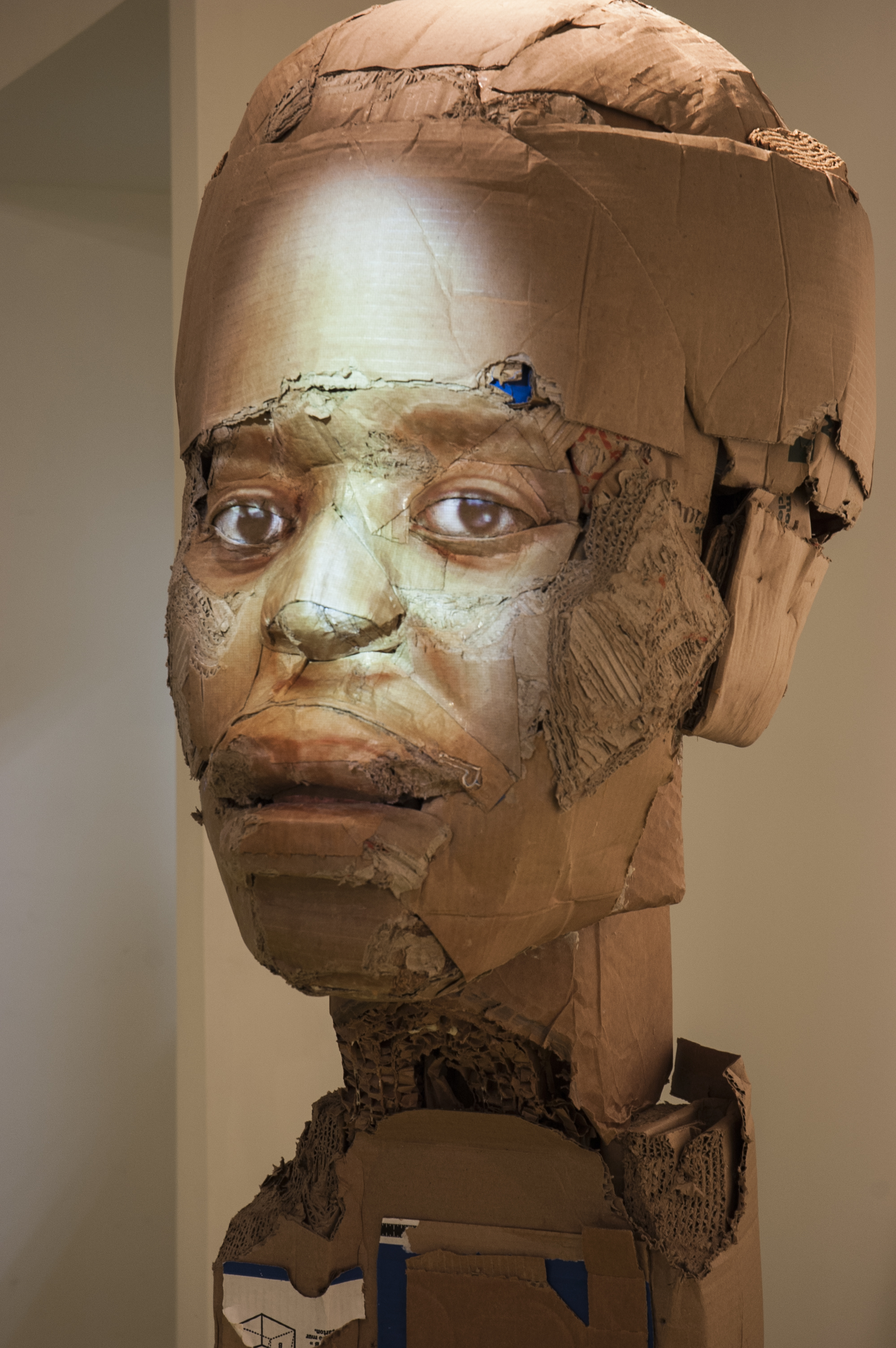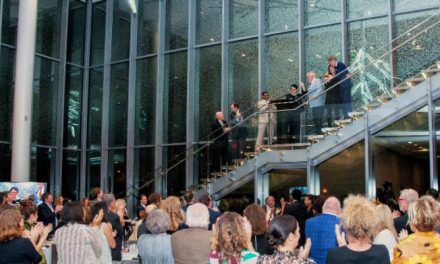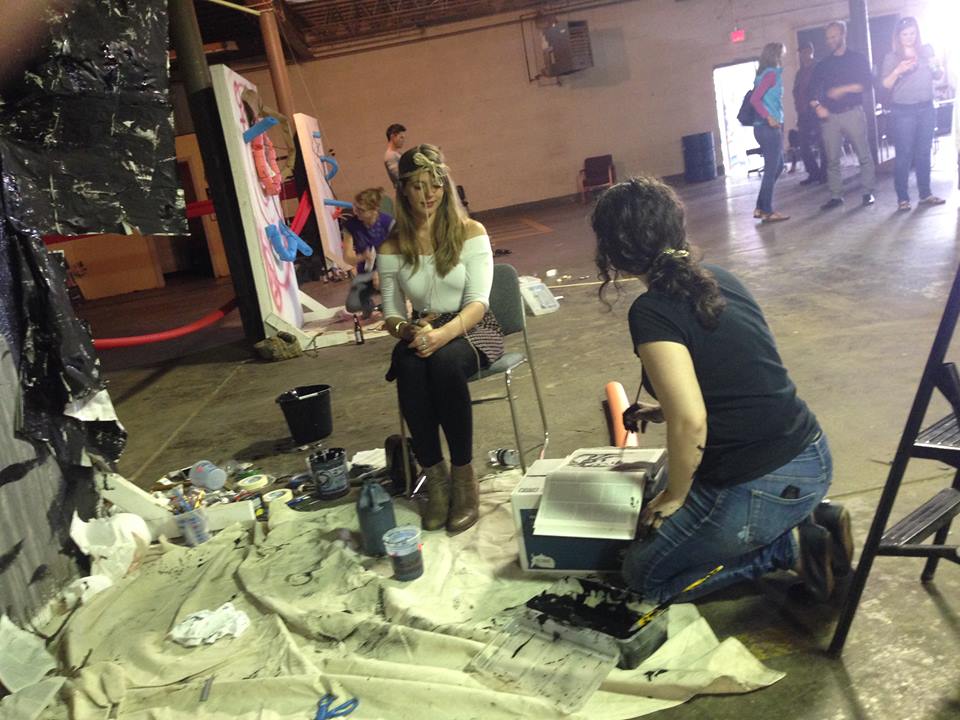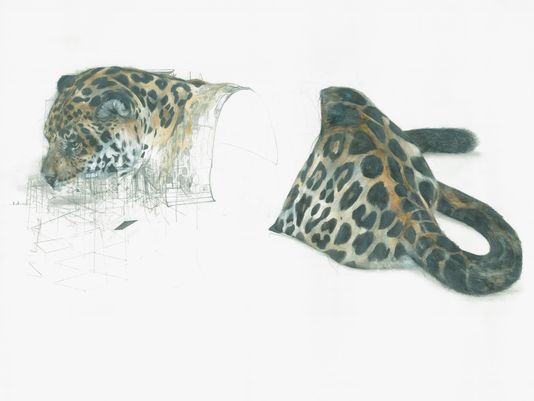Stephen Flemister “Profile of a Thismia”, 2013, Cardboard bust and video projection, 58” x 35” x 24”
#BlackArtMatters
Review by Kaylyn Taylor
Entire contents are copyright © 2017 Kaylyn Taylor. All rights reserved.
#BlackArtMatters is an ensemble exhibit of ten artists. While the subject matter ranges from social activism to personal narrative, it is unified in the figure. All the artists reference the human form in their work, creating accessibility. This is an important aspect, as this exhibit is abundant in information.
Concerned with the concept of beauty, in The Colored Gaze Study, LaNia Roberts offers four large-scale self- portraits, with emphasis on her gaze. Initially the figure is represented from the waist up, in bright, dripping colors and an excess of negative space. Progressively the figure is cropped out, leaving only the face. This more resolved image, rendered in oils, is darker and more painterly. The planes of her face are more geometric and dramatic. Her eyes are cast in a downward gaze, but her brow is not furrowed, creating a more contemplative quality. Roberts challenges more conventional, commercial perceptions of beauty and reminds us that beauty is internal.
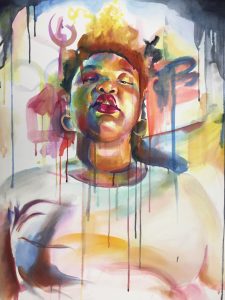
LaNia Roberts “The Colored Gaze Study”, 2016 Watercolor on matboard 38” x 30”
Stephen Flemister’s “Working Model of G Brooks” is also an enlarged portrait. This image is quartered by four large pieces of paper, and is a silkscreened, pixelated image. The colors are warm and muted. The unfinished edges of the paper create a cross hair, and the seams are aligned so that, again, the eyes become the focus. This gaze is warm, accompanied by a soft smile. Flemister’s multimedia “Profile of a Thismia” takes the digitized image and raises it. Projected onto a large cardboard bust is a continually running cycle of an images of a woman morphing into an image of Michele Obama, and then fading into a white light. Thismia is a variety of fungal thriving plant that is indigenous to the southern hemisphere. It was also once, curiously, found in the Chicago area of Illinois, but is now extinct due to development. The fading of the image alludes to the fading of the flower; beauty needlessly destroyed.
The pieces by Fahamu Pecou are large works as well. In both “Black Beauty,” and “Night Catches Us,” an isolated male fills the canvas. These powerful males are stooping, bent forward, gazing down. The background is black, and gold gilds the skin, lending a richness, but not a great deal of brightness. Why are they gilded? Placed through the lens of Hip Hop and popular culture, perhaps it is a reference to the expectations placed on the African American male to be successful; the Golden Boy? In contrast to this intensity are the smaller compositions by Natasha Giles. In her works the figures are brought into focus by clearly depicting the figurative image and surrounding it with a soft, faded, hatch-marked background. “Incredible Bosco” depicts a young woman, placed left of center, who is in profile with her back to the viewer. She is holding and sipping from a mug. The background is a textural pink. The detail of this figure, compared to the undefined, monochromatic background draws attention to the captured moment.
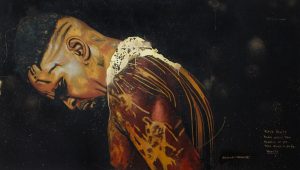
Fahamu Pecou, “Black Beauty”, 2016, 48″ x 84″, Acrylic, enamel, spray paint & gold leaf on canvas
The portrait array by Robyn Gibson incorporates an auditory aspect, which adds dimension to her composition. Nine small portraits, arranged in a 3’ x 3’ grid are accompanied by the recorded interview the artist made of each of her subjects. In contrast to a transcript, which offers only words, the recordings provide the voice, inflection, and intention of the interviewee, as well as insight into the creative process of the interviewer. Dread Scott’s “Wanted” contains an interview process as well. In the video component of this mixed media piece, a police sketch artist is filmed drawing images of briefly viewed teens, as described by older people. The artist prompts the interviewee for details and references a book of facial types to help the process. These images are then printed in a ‘wanted’ poster format, with the crimes being daily activities and attitudes typical to that age group. The social commentary stands in sharp contrast to the images offered by Gibson. The policing of predominantly Latino and African American youth is brought into the gallery space. The filter of judgement and the question of profiling renders the resulting images as stark, rather than full.
Scott’s image “Join the Negro Rifle Association” and Tillet’s photographic pieces are sociopolitical narratives. Scott’s striking image of a young African American toting a gun on his shoulder instantly calls attention to the double standard surrounding gun ownership in today’s society. Scheherazade Tillet’s images “International Anti-Street Harassment Day,” and “Speak,” directly address the experiences of African American females. The Anti-Street Harassment image shows a queue of young women marching with signs, demanding the right to feel respected in their own environment. The approaching figure in the foreground stares out, past the picture plane, challenging. In “Speak,” a young woman holds a drawn image of, presumably, herself with the words ‘I am Not Heard’ covering her mouth. The telescopic image within the image tells the story of the pain of not being acknowledged, all too common of a phenomenon. The social deafness is multi-dimensional. Tillet’s “Black Girls, Good Friday morning, Westside Chicago, Illinois,” is a remedy to this underrepresentation. It is a response to the 1941 image by Russell Lee.
“He photographed black boys sitting on a car on Easter Sunday,” Tillet
explained. “So many black Americans have this photograph in their
homes; it represents Chicago. But it doesn’t have any girls in it.” (Frank)
Christina Long’s journal and date book, and Ray Dalton’s collages offer a more personal experience. In her journal, Long describes her experiences with word, images, collages while her datebook is composed mainly of collage. A first hand narrative is given of the artist’s impressions and the pursuer is invited deeply into the creative process; it would be gratifying to see some of those images in a more resolved format. Dalton’s five collages, three indoor and two cityscapes, access a sense of nostalgia through the use of vintage photographs. A slice of time is carefully reconstructed, and the figures are a part of a larger environment. There is a sense of continuity presented, as the activities of the figures, the interior, and the buildings are commonplace in this timeframe.
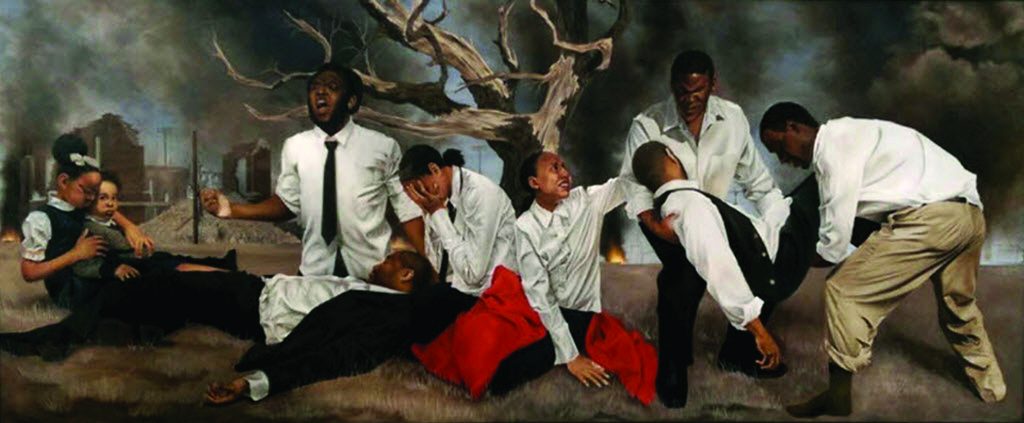
Shawn Michael Warren, “In A Promised Land”, 2015, Oil on canvas, 74″ x 180″
Shawn Michael Warren’s large, sweeping canvas, “In a Promised Land,” is an epic composition harkening to Goya’s “Third of May 1808” – a stark, beautifully rendered image of oppression and violence that it depicts the impact of the Tulsa Race Riots of 1921. This history painting, with its dark background, destroyed cityscape, angst ridden faces, broken bodies, Pieta reference, and swath of symbolic red, serves to bring awareness to a suppressed piece of US History, the annihilation of a thriving African American community and it’s citizens by white mobs. Warren purposely utilizes the technique of the old masters to anchor this narrative in time. No longer can this event be ignored.
All of the contributing artists in #BlackArtMatters are African American. It is impossible to separate the essence of their experiences from their subject matter, as art inherently contains subjectivity, to some degree. What is offered here is a chance to broaden our own minds, and to see both the similarities and the differences of our own experiences.
#BlackArtMatters
February 3 – April 8, 2017
Carnegie Center for Art and History
201 E. Spring Street
New Albany, IN 47150
(812) 944-7336
www.carnegiecenter.org
Kaylyn Taylor is an artist and writer living in Louisville with her husband and two children. She holds a BA in English & Humanities with a minor in Art from the University of Louisville. She was formerly the General Manager for Savage Rose Classical Theatre Company.
Works Cited:
Frank, Priscilla, “How Photography Helps Black Girls Define Their Voice On Their Own
Terms.” Huffington Post, 04/15/2016, http://www.huffingtonpost.com/entry/how-photography-helps-black-girls-define-their-culture-on-their-own-terms_us_570ff602e4b0018f9cb971cb. Accessed Feb.12, 2017.
http://www.efloras.org/florataxon.aspx?flora_id=1&taxon_id=242101975.
FNA Vol. 26 Page 488, 489

